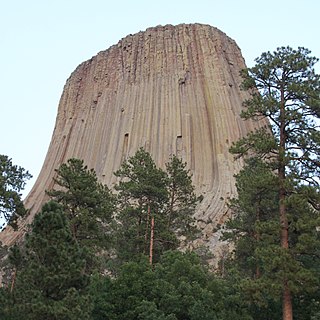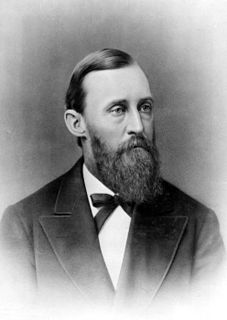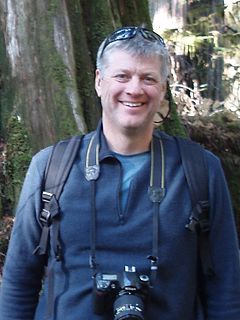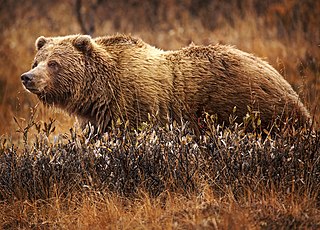Related Research Articles

Yellowstone National Park is an American national park located in the western United States, with parts in Wyoming, Montana and Idaho. It was established by the U.S. Congress and signed into law by President Ulysses S. Grant on March 1, 1872. Yellowstone was the first national park in the U.S. and is also widely held to be the first national park in the world. The park is known for its wildlife and its many geothermal features, especially Old Faithful geyser, one of its most popular. While it represents many types of biomes, the subalpine forest is the most abundant. It is part of the South Central Rockies forests ecoregion.

Devils Tower is a butte, possibly laccolithic, composed of igneous rock in the Bear Lodge Ranger District of the Black Hills, near Hulett and Sundance in Crook County, northeastern Wyoming, above the Belle Fourche River. It rises 1,267 feet above the Belle Fourche River, standing 867 feet from summit to base. The summit is 5,112 feet above sea level.

The Lamar River is a tributary of the Yellowstone River, approximately 40 miles (64 km) long, in northwestern Wyoming in the United States. The river is located entirely within Yellowstone National Park.

Ferdinand Vandeveer Hayden was an American geologist noted for his pioneering surveying expeditions of the Rocky Mountains in the late 19th century. He was also a physician who served with the Union Army during the Civil War.
Richard Ellis is an American marine biologist, author, and illustrator. He is a research associate in the American Museum of Natural History's division of paleontology, special adviser to the American Cetacean Society, and a member of the Explorers Club. He was U.S. delegate to International Whaling Commission from 1980 to 1990.

Norbert Schramm is a German former competitive figure skater. He is a two-time European champion, a two-time World silver medalist, and a three-time German national champion.

The northwestern wolf, also known as the Mackenzie Valley wolf, Rocky Mountain wolf, Alaskan timber wolf, or Canadian timber wolf, is a subspecies of gray wolf in western North America. It ranges from Alaska, the upper Mackenzie River Valley; southward throughout the western Canadian provinces, aside from prairie landscapes in its southern portions, as well as the Northwestern United States.

Yellowstone National Park has over 1,100 miles (1,800 km) of blazed and mapped hiking trails, including some that have been in use for hundreds of years. Several of these trails were the sites of historical events. Yellowstone's trails are noted for various geysers, hot springs, and other geothermal features, and for viewing of bald eagles, ospreys, grizzly bears, black bears, wolves, coyotes, bighorn sheep, pronghorns, and free-ranging herds of bison and elk.

Eagle Peak is a mountain in the Absaroka Range in the U.S. state of Wyoming and at 11,372 feet (3,466 m) is the highest point in Yellowstone National Park. It is located about 6 miles (9.7 km) east of the southeast arm of Yellowstone Lake.

Hayden Valley is a large, sub-alpine valley in Yellowstone National Park straddling the Yellowstone River between Yellowstone Falls and Yellowstone Lake. The valley floor along the river is an ancient lake bed from a time when Yellowstone Lake was much larger. The valley is well known as one of the best locations to view wildlife in Yellowstone.

Harvey Locke is a conservationist, writer, and photographer. He is a recognized global leader in the field of parks, wilderness, wildlife and large landscape conservation. He is a founder of the Yellowstone to Yukon Conservation Initiative, with the goal to create a continuous corridor for wildlife from Yellowstone National Park in the United States to the Yukon in Northern Canada. In 2017, Locke was appointed chair of the IUCN World Commission on Protected Areas Beyond the Aichi Targets Task Force, with the goal of ensuring the new global conservation targets set at the next Conference of the Parties of the Convention on Biological Diversity in 2020 are meaningful for achieving the conservation of nature and halting of biodiversity loss.

Specimen Ridge, el. 8,379 feet (2,554 m) is an approximately 8.5-mile (13.7 km) ridge along the south rim of the Lamar Valley in Yellowstone National Park. The ridge separates the Lamar Valley from Mirror Plateau. The ridge is oriented northwest to southeast from the Tower Junction area to Amethyst Mountain. The ridge is known for its abundance of amethyst, opal and petrified wood. It was referred to as Specimen Mountain by local miners and was probably named by prospectors well before 1870. The south side of the ridge is traversed by the 18.8-mile (30.3 km) Specimen Ridge Trail between Tower Junction and Soda Butte Creek. The trail passes through the Petrified Forest and over the summit of Amethyst Mountain el. 9,614 feet (2,930 m).

Druid Peak is a moderate domed peak on the southern flank of the Absaroka Range in Yellowstone National Park. The peak lies just north of the Lamar River and Soda Butte Creek confluence at the head of the Lamar Valley. Prior to 1885, this summit was named Soda Hill by members of the Hayden Geological Survey of 1878 and Mount Longfellow or Longfellows' Peak by then park superintendent Philetus Norris in 1880. In 1885, members of the Arnold Hague Geological Survey changed the name to Druid Peak for unknown reasons, but some historians believe it may have been the presence of Stonehenge like rock formations on its eastern face that prompted the name.

The grizzly bear, also known as the North American brown bear or simply grizzly, is a large population or subspecies of the brown bear inhabiting North America.

Yellowstone Bear World is a privately owned drive-thru wildlife park. It is located in Rexburg, Idaho, near Yellowstone National Park. It was established in 1998.

Casey Anderson is an American wildlife naturalist, television host, animal trainer and actor who is best known as the host and executive producer of the Nat Geo WILD channel television series, Expedition Wild and America the Wild with Casey Anderson, and for being the trainer and "best friend" of Brutus the Bear, a grizzly bear that he adopted as a newborn cub. Brutus, trained by Anderson, has appeared in many films, documentaries, television commercials, and live educational shows across the United States.
Frank Cooper Craighead Jr. and John Johnson Craighead, twin brothers, were American conservationists, naturalists, and researchers who made important contributions to the study of falconry and grizzly bear biology. Born in Washington, D.C. where both graduated from Western High School in 1935, the brothers began collecting and identifying animals and plants they found alongside the Potomac, and soon expanded their interests to birds and hawks, going west in 1934 to begin studying falconry. After the war, during which they were employed as survival trainers, they each married and resumed their work in falconry. During the 1950s they expanded their work to other animals, including many species living in and around Yellowstone, and eventually separated.
Thomas D. Mangelsen is an American nature and wildlife photographer and conservationist. He is most famous for his photography of wildlife in the Greater Yellowstone Ecosystem, as he has lived inside the zone in Jackson, Wyoming, for over 40 years. In 2015, he and nature author Todd Wilkinson created a book, The Grizzlies of Pilgrim Creek, featuring a grizzly bear known as Grizzly 399, named so due to her research number. He has been active in the movement to keep the Yellowstone area grizzly bears on the Endangered Species List. Mangelsen is also known for trekking to all seven continents to photograph a diverse assortment of nature and wildlife. A photograph he took in 1988 titled, "Catch of the Day" has been labeled "the most famous wildlife photograph in the world". In May 2018, he was profiled on CBS 60 Minutes. He has received dozens of accolades throughout the decades.
Heinrich Caesar Berann was an Austrian painter and cartographer. He achieved world fame with his panoramic maps that combined modern cartography with classical painting. His work includes maps of Olympic Games sites, of mountainous regions published in the National Geographic Magazine, and four panorama posters of national parks published by the U.S. National Park Service.
References
- ↑ "Norbert Rosing". National Geographic. Retrieved March 13, 2014.